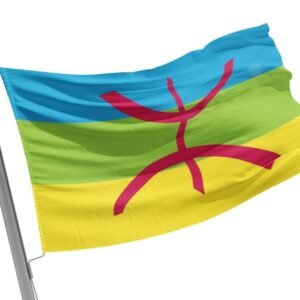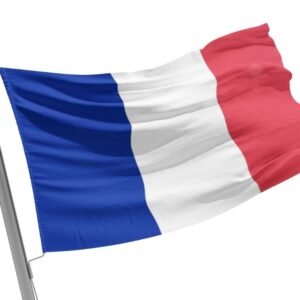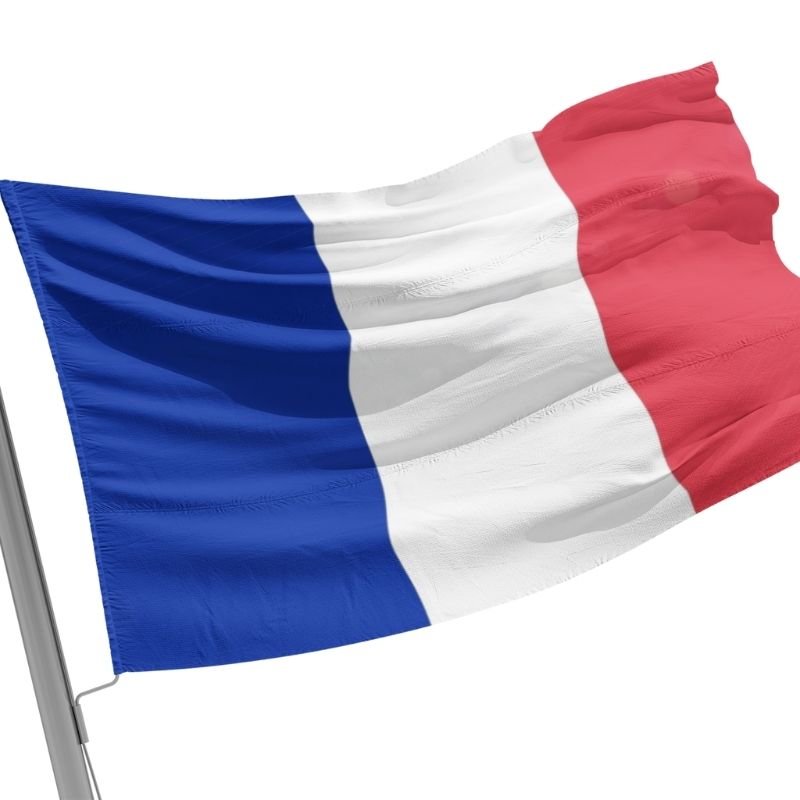
The French Flag: History, Origin and Evolution
The French flag stands as one of the world’s most recognizable national emblems. Its distinctive vertical bands of blue, white, and red have represented France for over two centuries, becoming not just a symbol of a nation but an enduring icon of revolutionary ideals. Born in the flames of revolution, this flag has witnessed the transformation of France from monarchy to republic and has inspired democratic movements across the globe.
Quick Summary
The iconic French flag with its blue, white, and red vertical bands stands as one of history’s most influential national emblems. This tricolor design emerged during the French Revolution, transforming from a simple cockade in 1789 to become the enduring symbol of France.
Before the Revolution, France was represented by the royal white flag adorned with golden fleur-de-lis. The revolutionary innovation came when the Marquis de Lafayette combined the blue and red colors of Paris with the royal white to create a symbol of unity between the monarchy and the people.
Initially appearing as a cockade in July 1789, the design evolved into a flag by 1790, though with colors arranged differently, red, white, and blue. By 1794, the current blue-white-red arrangement was standardized under the First Republic, with artist Jacques-Louis David contributing to its design.
The tricolor faced interruption during the Bourbon Restoration (1814-1830) when the white royal flag briefly returned. However, the July Revolution of 1830 permanently established the tricolor as France’s national emblem, a status it has maintained through multiple republics, empires, and political transformations.
Over time, the symbolism of the colors evolved to represent Liberty (blue), Equality (white), and Fraternity (red), the core values of the French Republic. The flag has undergone subtle refinements, most recently in 2021 when President Macron returned to a darker navy blue, replacing the lighter shade used since 1976.
The French flag’s influence extends globally, inspiring numerous national flags with tricolor designs. Its constitutional status was formalized in 1958, and it continues to serve as a powerful symbol of French identity, revolutionary heritage, and republican values worldwide.
Origins of the French Flag
Before the Revolution that would transform France and much of Europe, the kingdom flew a very different banner. For centuries, France was represented by a solid white flag adorned with the golden fleur-de-lis, the emblem of the Bourbon dynasty. This royal standard symbolized the absolute monarchy that had ruled France since medieval times.
The story of the French flag begins amid the political turmoil of 1789. As revolutionary fervor swept through Paris, the city was already associated with two colors: blue and red. These had been the traditional colors of Paris since the time of Étienne Marcel in the 14th century. These colors appeared on uniforms and banners throughout the city as revolutionary sentiment grew.
The decisive moment came shortly after the storming of the Bastille on July 14, 1789. The Marquis de Lafayette, a key revolutionary figure who had fought in the American Revolution, sought a symbol that could unite the French people during this period of intense change. In a gesture of reconciliation between the revolutionary citizens and King Louis XVI, Lafayette proposed combining the blue and red of Paris with the royal white.
This combination first appeared not as a flag but as a cockade, a circular badge worn on hats or clothing. On July 17, 1789, when King Louis XVI visited the Hôtel de Ville in Paris, he was presented with this tricolor cockade, symbolically accepting the revolution while maintaining his position as monarch. The king pinned the cockade to his hat, creating a powerful image of attempted unity between the crown and the revolutionary movement.
The visual statement was clear. The red and blue represented the people of Paris and their revolutionary fervor, while the white represented the monarchy. Together, they suggested a new France where royal authority would be balanced by the will of the citizens. This delicate symbolism reflected the initial hopes for a constitutional monarchy rather than the republic that would eventually emerge.
For those seeking to display an authentic representation of this pivotal moment in French history, the Cosmoflag collection includes meticulously researched reproductions of early revolutionary flags, crafted with premium materials that honor their historical significance.
Birth During Revolution (1789-1794)
The transition from cockade to flag was not immediate. In its earliest incarnation as a flag in 1790, the tricolor appeared with a different arrangement than we know today. The red band was positioned nearest to the flagpole, followed by white and then blue. This early version was first used by the French navy and gradually gained wider acceptance.
The National Constituent Assembly officially adopted this tricolor design in 1790 as a naval ensign and military flag. It represented a France in transition, no longer an absolute monarchy but not yet a republic. The flag flew alongside other revolutionary symbols as France experienced increasingly radical political change.
A significant evolution occurred in 1794 during the period known as the First Republic. The National Convention, the revolutionary government that had overseen the execution of King Louis XVI, officially standardized the flag with its current arrangement of vertical bands: blue nearest to the flagpole, white in the center, and red on the fly end.
The renowned painter Jacques-Louis David, who served as the unofficial artistic director of the French Revolution, contributed to finalizing this design. David understood the power of visual symbols in communicating revolutionary values and helped establish the tricolor as the definitive emblem of the new France.
This period saw the French flag firmly established as more than just a national banner. It became a powerful symbol of revolutionary change. As French armies carried it across Europe during the revolutionary wars, the tricolor represented not just a nation but an ideology that challenged the established monarchical order throughout the continent.
The flag’s design was remarkably simple yet effective. Three equal vertical bands of color, without embellishment or insignia. This simplicity contrasted sharply with the ornate royal standards of the era and visually communicated the revolutionary rejection of aristocratic excess in favor of rational, egalitarian principles.
Symbolism Through Time
The meaning attributed to the three colors of the French flag has evolved significantly through the centuries. During the tumultuous period of the Revolution, the colors were initially understood through their connection to specific historical and cultural elements of France.
Blue was associated with Saint Martin, a Roman soldier who became bishop of Tours and was considered a patron of France. Red recalled Saint Denis, the martyred bishop of Paris and another patron saint of the nation. White, as previously established, represented the monarchy and sovereign authority.
As the Revolution progressed, these religious and monarchical associations gave way to more philosophical interpretations aligned with the revolutionary ideals. The colors came to embody the famous revolutionary motto “Liberté, Égalité, Fraternité” (Liberty, Equality, Fraternity). Blue representing liberty, white symbolizing equality, and red standing for fraternity or brotherhood.
This symbolic trinity perfectly captured the aspirations of revolutionary France and continues to define French national identity to this day. The simplicity of this color symbolism contributed to its enduring power, making the flag accessible and meaningful to citizens of all backgrounds.
During the Napoleonic era, the tricolor remained in use, though often accompanied by imperial eagles and other symbols of the Bonapartist regime. Napoleon understood the powerful symbolic value the flag had acquired in the hearts of the French people and wisely maintained it while adding his own imperial elements for formal occasions.
The Cosmoflag collection includes historical variations from this period, allowing collectors to appreciate how the flag adapted through different political epochs while maintaining its essential tricolor identity.
Historical Interruptions
Despite its revolutionary origins and popular support, the French flag has not flown continuously throughout French history. Its journey reflects the political turbulence that characterized France in the 19th century.
Following the defeat of Napoleon and the restoration of the Bourbon monarchy in 1814, King Louis XVIII restored the white flag with fleur-de-lis as the national emblem. This return to royalist symbolism represented a rejection of revolutionary and Napoleonic legacies. For a period of sixteen years, the tricolor was officially abandoned.
The July Revolution of 1830 marked a turning point. When Charles X attempted to further restore absolute monarchy and was overthrown, the tricolor flag was permanently reinstated under the “Citizen King” Louis Philippe. This moment represented the final victory of revolutionary symbolism over royal heraldry.
Since 1830, despite dramatic changes in government from the Second Republic to the Second Empire under Napoleon III, through the Third and Fourth Republics, and into the current Fifth Republic established in 1958, the tricolor has remained the unquestioned national emblem of France.
During the German occupation in World War II, the tricolor continued to fly in Vichy France, though the Vichy regime added their own symbols to it in certain contexts. Meanwhile, the Free French forces led by Charles de Gaulle proudly used the unaltered tricolor as a symbol of resistance and the true France fighting for liberation.
This continuity across radically different political regimes speaks to how the flag transcended its revolutionary origins to become a universal symbol of French identity, regardless of political alignment. The tricolor successfully transformed from a partisan revolutionary symbol to a unifying national emblem.
For those interested in the historical variations of the French flag across these different eras, Cosmoflag offers museum-quality reproductions that capture the subtle differences in proportions and shades that have characterized the flag through different periods.
Modern Refinements
The French flag has maintained its fundamental design since 1830, but subtle refinements have occurred over time, particularly regarding the exact specifications of colors and proportions. These changes, while not immediately obvious to casual observers, reflect evolving aesthetic preferences and political contexts.
In 1976, under President Valéry Giscard d’Estaing, France adopted a lighter shade of blue for the flag. This modification aligned the blue more closely with the color of the European flag, symbolizing France’s commitment to European integration. The change was subtle yet significant, shifting from a traditional navy blue to a brighter, more vibrant hue.
However, in 2021, President Emmanuel Macron made a notable adjustment, returning to the darker navy blue that had been used before 1976. This decision was not announced with fanfare but quietly implemented on presidential buildings and official settings. The deeper blue connects the modern flag more closely with its revolutionary origins and traditional representation.
The return to navy blue also served a practical purpose, creating more visual distinction between the French national flag and the European Union flag. This subtle shift highlights France’s individual identity within the European community.
Another specification that has been standardized over time is the exact proportion of the flag. The official ratio is now 2:3, meaning the width is two-thirds of the length. This proportion creates a balanced appearance when the flag is displayed, neither too elongated nor too square.
The Cosmoflag collection includes both contemporary and historical versions of the French flag, crafted with precise attention to these color specifications. This allows collectors and institutions to display flags that accurately represent either current standards or specific historical periods.
International Influence
The French flag has exerted an extraordinary influence on flag designs around the world. Its tricolor pattern pioneered a new approach to national symbolism that moved away from complex heraldic designs toward simpler, more democratic visual statements.
Following the French Revolution and the Napoleonic era, the tricolor concept spread across Europe and beyond. The Italian flag adopted the same vertical tricolor format with green, white, and red. Belgium chose vertical bands of black, yellow, and red for their national flag after gaining independence in 1831. Ireland, Mexico, Romania, and numerous other nations also adopted tricolor designs, though some opted for horizontal rather than vertical bands.
This widespread adoption speaks to the powerful symbolic language that the French flag established. The tricolor concept communicated ideals of nationhood, citizen sovereignty, and break from monarchical or colonial rule. Nations emerging from revolutionary struggles or seeking independence found in the tricolor format an effective visual shorthand for their aspirations.
Beyond direct imitation, the French flag influenced the general movement toward simpler, more recognizable national flags. The revolutionary concept that a nation should have a distinctive, easily reproducible symbol that ordinary citizens could create and display represented a democratization of national imagery.
The influence extends to colonial and post-colonial contexts as well. Many former French colonies incorporated elements of the tricolor into their own flags upon independence, either adopting similar colors or the vertical triband format. This created a visual family of flags that acknowledges historical connections while asserting new national identities.
For collectors and those interested in vexillology, Cosmoflag offers educational flag sets that demonstrate the influence of the French tricolor on global flag design, perfect for schools, museums, or personal collections focused on international relations.
Constitutional Status
The French flag’s position as the preeminent national symbol is formally enshrined in law. Article 2 of the Constitution of the Fifth Republic, established in 1958, explicitly states: “The national emblem is the tricolor flag, blue, white, red.” This constitutional recognition places the flag at the highest level of national symbols, alongside the national anthem “La Marseillaise” and the national motto “Liberty, Equality, Fraternity.”
This constitutional protection reflects the deep importance of the tricolor in French identity and governance. Unlike some countries where flag specifications are determined by legislative acts or executive orders that can be more easily changed, France has elevated its flag to constitutional status, requiring constitutional amendment to alter its basic design.
Official protocol regarding the display and use of the French flag is governed by specific regulations. The flag must be treated with respect, never allowed to touch the ground, and properly illuminated if displayed at night. When displayed with other national flags, strict protocols of precedence are followed according to diplomatic custom.
The flag is prominently featured at all official government buildings, from the Élysée Palace, the official residence of the French President, to town halls in the smallest communes. It appears at schools, courts, police stations, and all public institutions as a constant reminder of the republic and its values.
On national holidays, particularly Bastille Day (July 14), the flag is ubiquitous throughout France. Citizens display it from homes and businesses, while elaborate tricolor decorations adorn public spaces. The military parade on the Champs-Élysées features the flag prominently, carried by representatives of different branches of the armed forces.
During times of national mourning, the flag is flown at half-mast on public buildings, a solemn gesture decreed by the President or Prime Minister. This practice underscores the flag’s role as an emblem that unites the nation in both celebration and sorrow.
The exact color specifications for official flags are managed by the French government. The current standard specifies not only the shade of blue discussed earlier but also the precise red to be used. The official red is a deep, slightly darkened shade rather than a bright scarlet, creating a harmonious balance with the navy blue.
For those requiring flags that meet official specifications for governmental, diplomatic, or formal institutional use, Cosmoflag produces French tricolor flags that adhere precisely to current constitutional standards, ensuring absolute accuracy for official settings.
Legacy and Global Recognition
The French flag today ranks among the most instantly recognizable national symbols in the world. Its simple yet distinctive design has achieved iconic status, immediately evoking associations with France, French culture, and the values of the French Republic.
Beyond its official function, the tricolor has become a powerful cultural shorthand, appearing in countless contexts from sporting events to artistic expressions. French athletes wrap themselves in the flag after victories, while artists incorporate its colors into works exploring themes of French identity.
The flag has demonstrated remarkable resilience across changing political landscapes. Through monarchies, empires, republics, occupations, and liberations, the tricolor has emerged as the enduring symbol of France. This continuity speaks to how successfully it transcended its revolutionary origins to become accepted across political divides.
In international contexts, the French flag represents one of the world’s major powers, a permanent member of the UN Security Council, a nuclear state, and a founding member of the European Union. When flown at international organizations or during diplomatic events, it carries the weight of France’s historical and contemporary global influence.
The tricolor also serves as a symbol of the broader Francophone world, representing not just France but the cultural and linguistic heritage shared by French-speaking populations across multiple continents. This gives the flag significance beyond national borders.
For those wishing to display this globally recognized emblem, whether for cultural, educational, or decorative purposes, Cosmoflag offers French flags in various sizes and materials, from desktop models to large outdoor versions suitable for any setting where French identity or Francophile sentiment wishes to be expressed.













